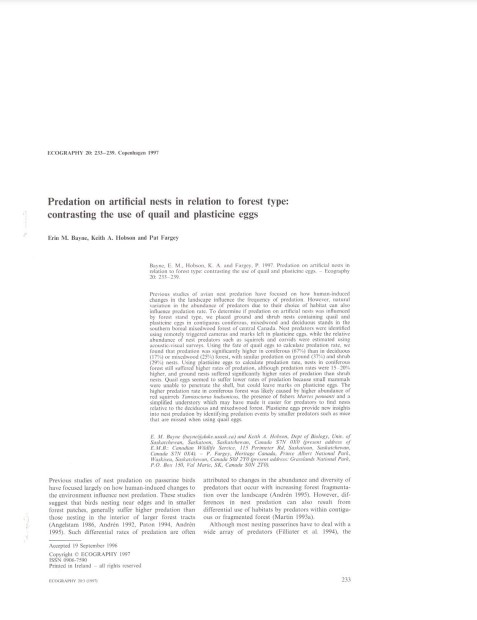Predation on artificial nests in relation to forest type: contrasting the use of quail and plasticine eggs
Bosque Modelo:
Prince Albert
Temática:
Conservación
Tipo de documento:
Artículo científico
Resumen
Previous studies of avian nest predation have focused on how human-induced changes in the landscape influence the frequency of predation. However, natural variation in the abundance of predators due to their choice of habitat can also influence predation rate. To determine if predation on artificial nests was influenced by forest stand type, we placed ground and shrub nests containing quail and plasticine eggs in contiguous coniferous, mixedwood and deciduous stands in the southern boreal mixedwood forest of central Canada. Nest predators were identified using remotely triggered cameras and marks left in plasticine eggs, while the relative abundance of nest predators such as squirrels and corvids were estimated using acoustic-visual surveys. Using the fate of quail eggs to calculate predation rate, we found that predation was significantly higher in coniferous (67%) than in deciduous (17%) or mixedwood (25%) forest, with similar predation on ground (37%) and shrub (29%) nests. Using plasticine eggs to calculate predation rate, nests in coniferous forest still suffered higher rates of predation, although predation rates were 15-20% higher, and ground nests suffered significantly higher rates of predation than shrub nests. Quail eggs seemed to suffer lower rates of predation because small mammals were unable to penetrate the shell, but could leave marks on plasticine eggs. The higher predation rate in coniferous forest was likely caused by higher abundance of red squirrels Tamiasciurus hudsonicus, the presence of fishers Martes pennanti and a simplified understory which may have made it easier for predators to find nests relative to the deciduous and mixedwood forest. Plasticine eggs provide new insights into nest predation by identifying predation events by smaller predators such as mice that are missed when using quail eggs.
Información Bibliográfica
Autor:
Bayne, EM, KA Hobson and P Fargey.
Revista:
Ecography
Año:
1997
N°:
3
País :
Canadá
Páginas:
233 - 239
Volumen:
20
Idioma:
Ingles
Palabras claves
Model forest, Adaptatation, Canada





